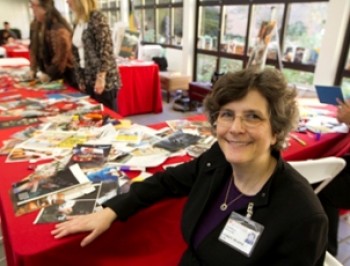The benefits of the arts to both patient and practitioner
The benefits of the arts to both patient and practitioner
A splash of acrylic paint on canvas. An overture from Mozart. A stanza of Rilke’s poetry.

Each of these artistic endeavors helps patients heal in a strange environment: the hospital. Studies have shown that patients who participate in the creative arts, whether painting, writing, or listening to music, experience a reduction in adverse physiological and psychological outcomes. But the creative arts can also help health care practitioners to better understand and appreciate the experiences of patients, according to Audrey Shafer, MD, director of the Program on Arts, Humanities, and Medicine and the keynote speaker at an Arts Program event at Stanford Hospital & Clinics yesterday.
During her talk she described how each of us, to varying degrees, has had direct experience as patients, as caregivers or as witnesses to the suffering of close family members or friends. And Shafer, a practicing anesthesiologist, explained how arts in the medical setting can give health care practitioners unique insight:
A doctor or nurse may know about the pathophysiology of broncho-constriction in asthma and how to administer beta-adrenergic agonists – but what about the experience of not being able to breathe, or how instability in the home life may be precluding regular medication routines? Arts in health care can really give a glimpse into that experience.
In reading literature we come to appreciate the nuances of illness, the many presentations, the ambiguities and incompleteness of treating chronic illness, the implications of the particulars.
You need the science, absolutely, but you also gain from the art.
Shafer also related her experiences with veterans of the Iraq war, in which soldiers who were about to have surgery wanted to talk about their war experiences in the holding room before entering the operating room:
What was I to do? Try to divert the conversation to something more pleasant, less anxiety-provoking in these minutes before surgery? What I discovered was that the veterans needed that moment – a moment they themselves found critical, to talk about their concern and profound empathy for the soon-to-be deployed soldiers. And, there I was, a privileged witness to their stories.
Those experiences resulted in Shafer’s writing “The Mailbox”, a story about post-traumatic stress in Vietnam war veterans.
Shafer said that paying attention to what the arts offer give perspectives we cannot otherwise imagine. Which is what happened when she wrote the poem, Anesthesia. A stanza:
A slur of lights/a path/the thick dry tongue of reembodiment/voices calling, locating a thaw/you emerge as if from a chrysalis
###
Photo of Shafer by Norbert von der Groeben
* Stanford University Medical Center integrates research, medical education and patient care at its three institutions – Stanford University School of Medicine, Stanford Hospital & Clinics and Lucile Packard Children’s Hospital.
** The above story is adapted from materials provided by Stanford University School of Medicine
________________________________________________________________




















